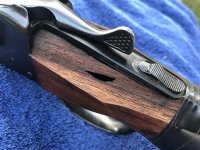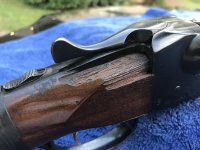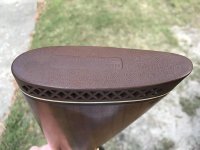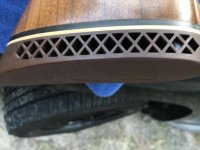No glue generally,,just screwed on.
(Unless the person that did the job decided glue as an added fastener would be a nice touch!)
In pic#4 you can see where the upper screw is positioned by the light colored spacer/tube you can see within the vent area of the pad.
If you pull the face of the pad apart at the center with your opposing thumbs, it should expose those razor slits that Browningcollector mentions.
The screws are pushed through those clean cuts in the rubber pad and then the pad closes back up to hide the evidence of the screw position.
The screws are generally phillips head type that's what is supplied in the package with the pads as sold,
But I've run accross regular slotted head screws being used as well usually on older guns.
Even Drywall screws with that square drive socket head on them.
Use some grease on the pad and the screwdriver tip so as not the tear the rubber up in removing or installing. In this case if you are thinking of re-using the pad.
Often you can remove one screw and simply swivel the pad to the side to expose the hole where the through bolt is located.
Make sure the one screw removed is clear of the bottom of the pad so it doesn't scar the edge of the wood when the pad is swung over.
If not,, remove both. The pad may back off the wood w/o the screws actually coming back out through the rear face of the pad.
A long shank screw driver or sometimes the through bolt is a hex drive bolt. Use a light to check and see.
A slim socket and a long extension drive on a socket wrench for the hex bolt type (Usually don't find many of these except on recent mfg guns)
If you use a straight blade screwdriver make sure the blade is actually in the slot of the bolt head and not laying along side of the head down in there when you crank on it to loosen.
If the latter is done, quite often the leverage of the blade against the side of the bolt head will split out the side of the stock.
Your stock can be saved.
Clean up the uneven splintered off edges and glue (epoxy) in new wood.
It's a simple flat inside surface. No inletting inside and a flat surface up against the back of the frame.
Epoxy bed it if you need to.
Reshape the repair pieces to conform to the orig stock shape and finish.
Many times it's a lot easier to repair than to fit a new pre-carve 95% stock and finish.
You may be able to find a take off orig mfg stock in good condition for a good price as an alternative. Ebay, ect.
They generally bolt right on but I'd pay close attention to the frame to stock inletting and glas bed it if needed.
The damage may have come from the stock being a bit loose,,no drawn up tight to the frame. Recoil pushes the action up and back and that cracks and breaks the top of the 'ears' of the stocks off.
IIRC a stock from the Stevens 311 should fit the Stevens/FOX B series as well.
But check the tang shape where it meets the frame on top,
There a couple different styles no matter which model, and one will not interchange with the other.
2 frame sizes as well IIRC.




